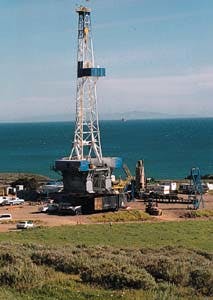Nabors Rig No. 90 on location and preparing to directionally drill the Gavioto No. 7 near Santa Barbara. Exxon's Hondo platform in background (Fig. 1; Photo courtesy John Stahl, president Molino Energy Co).Extended-reach drilling may alleviate California environmental concerns by targeting distant offshore plays using onshore localities adjacent to preexisting facilities.
If successful, it may set a precedent for offshore development without the use of new offshore platforms, thereby reducing the risk of offshore spills (OGJ, Oct. 7, 1997, p. 36).
Politicians, environmentalists, and the industry will closely watch the Gaviota No. 7 well, an extended-reach well operated by Benton Oil & Gas Co in partnership with Molino Energy Co. (Fig. 1). The companies aim to find sweet gas in the Gaviota structure, an anticline hemmed in by two faults, located about 11/4 miles offshore in the Santa Barbara Channel (Fig. 2 [130,105 bytes]).
Frank Rieber, project manager for Benton, characterizes the technologies used in the Gaviota No. 7, as "fairly routine." However, state officials hail this onshore-to-offshore technique as the only practical way to develop oil or gas in state waters, given the political and environmental constraints that have virtually closed all waters within the 3-mile limit for decades (OGJ, July 5, 1993, p. 20).
Proposed development is over three state leases, with known sweet-gas reserves in the Gaviota Matilija (State Tideland Lease 2199), Molino Matilija (2199 and 2920), and Caliente Matilija (2894) reservoirs, located at depths between 9,000 and 11,000 ft.
If enough sweet gas is found to make the project feasible, they'll go after the gas in the latter two fields. If their gas plans materialize, the partners may try for oil in the future. The Molino environmental impact report estimates total recoverable sweet-gas reserves between 200 and 300 bcf.
Drilling and production program
The Gaviota No. 7 well is planned as a long-reach, S-shaped hole with the final section going beyond vertical by 22°. According to Benton, the well will kick off at 450 ft and build angle at 5°/100 ft until an angle of 61.5° is achieved. Then a ramp ramp section will be maintained until 8,170 ft measured depth at a true vertical depth of 9,150 ft, drilling at an azimuth of 197°.Benton is not expecting to encounter any abnormal pressure and has planned for a trouble-free well, although multiple contingencies have been evaluated. The company hopes to drill most of the ramp section with a packed-hole assembly and is prepared to use mud motors and measurement-while-drilling tools if needed.
The casing is planned as 20 in. set at 432 ft, 133/8 in. at 3,110 ft, 95/8 in. at 9,430 ft, and a 7-in. liner set at TD at about 14,800 ft. The mud system is a water-based gel polymer system.
Driltek Professional Drilling Management of Bakersfield is providing drilling engineering services and well-site supervision. Nabors Drilling Co. Rig No. 90, outfitted with a CanRig top drive, has been contracted for the well. The National 1,500 hp rig is rated for a one million lb hook load.
As of Apr. 3, the company was drilling at a depth of 3,100 ft. The well is expected to take 75-85 days to reach TD.
The current project includes the construction of a test facility capable of handling 15 MMscfd. Pending a successful project, a 60 MMscfd facility would be constructed. After processing to remove condensate, water, and NGLs, the sweet gas will go into a nearby SoCal Gas Co. line.
If the Gaviota reservoir is successful, test wells will be drilled into the other leases. Full development may require 14 wells.
The Molino field was first developed in 1962 using subsea completions, producing at a peak rate of 48 MMscfd of natural gas and 1,000 b/d of NGL at an average depth of 6,000 ft. The five original wells were shut-in and abandoned in 1985.
Further testing occurred throughout the 1980s by Shell Western Exploration & Production Inc. (Swepi), indicating "that the Matilija formation has substantial volumes of sweet gas," according to the Arthur D. Little Co. and Aspen Environmental Group, coauthors of the environmental analysis.
Swepi applied for permits as part of its Hercules project in 1985, which envisioned an offshore platform. However, 3 years later it abandoned its plans because of intense political opposition.
The environmental analysis concludes that there are 13 state leases in the area that could be developed using directional drilling from an onshore location, most adjacent to federal Outer Continental Shelf (OCS) leases. Seven of those have only fair-to-poor onshore access and are unlikely candidates, leaving six as good to very-good candidates. The Molino project is aiming for three of these.
It will be the first energy project subject to a new revenue-sharing agreement between the state and local jurisdictions, thanks to a Senate bill (SB 1187) signed by Governor Wilson as a way to make such industrial ventures more palatable to the locals.
The federal Minerals Management Service (MMS) is also watching the project closely, as extended-reach drilling may be an answer to developing reserves between the state and OCS leases without adding new platforms. The MMS recently announced there are more oil and gas reserves off the California coast than previously estimated (OGJ, Mar. 16, 1998, pp. 93-96).
Molino was successful in winning permits through a unique pact with environmental opponents (OGJ, Oct. 7, 1996, pp. 36-37) and in March 1997 closed an agreement with Benton as the operator and part owner with a 40% share. Both companies are based in Santa Barbara County.
Copyright 1998 Oil & Gas Journal. All Rights Reserved.


